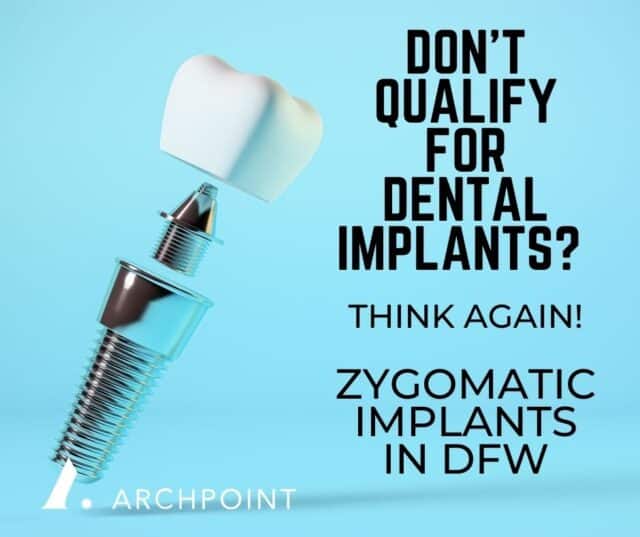Dental implants are one of the most life-changing treatments out there for people who have missing teeth. Unfortunately, not everyone qualifies for traditional dental implant treatment. But even if your dentist tells you that you’re not a candidate, there could be other implant options out there, such as Zygomatic dental implants. The only difference is these alternative implant designs are more specialized, so traditional family practice settings typically don’t have the resources available to offer them in their office.
If your dentist told you that you don’t qualify for implants, but you’re ready to explore all of your options, the implant specialists at ARCHPOINT could have a solution: Zygomatic dental implants.
Why Some People Can’t Get Traditional Implants
It’s physically impossible to place dental implants if you have severe bone loss. Anyone with extensive tooth loss or past periodontal disease may have weaker than normal bone, preventing typical implant installation. Or, if they can get implants, numerous osseous surgeries and grafting are needed to create a space for the implants beforehand. This approach can be lengthy, uncomfortable, and demoralizing for someone who just wants to replace their missing teeth.
There are other options out there, but it takes working with a skilled implant specialist to know what they are. These alternative designs use bone in other areas of your mouth rather than what’s traditionally surrounding healthy tooth roots. Our DFW Zygomatic dental implants are a graft-free procedure that penetrates the cheekbone (zygomatic arch) for retention, allowing them to function the same way as implants, except they’re longer and inserted at an angle.
Zygomatic implants are a great choice for patients who don’t qualify for traditional dental implants but still want a permanent tooth replacement.
Who Qualifies for Zygomatic Dental Implants?
Most candidates for Zygomatic implants are individuals who don’t qualify for everyday implant treatment. However, to be eligible for implant therapy, you must be at least 18 years old because we need to make sure all of your orofacial anatomy is completely developed. Most Zygomatic implant clients are much older than that, which is why they have extensive bone loss, so age restrictions normally aren’t a problem.
Additionally, you also need to go through a medical screening to determine if there are any other health issues that might contraindicate oral surgery. You may also need to disclose whether or not you’re taking any prescriptions for things like blood thinners and osteoporosis medications or if you’ve recently had any type of surgery or been hospitalized. Our implant specialists can connect with your medical provider to discuss any concerns beforehand, so even if you do have an extensive medical history, you may not need to rule out implants.
Access to 3D Imaging (CBCT Scans)
In addition to a physical dental exam, our DFW dentists also need to take a series of 3D scans to evaluate your oral anatomy. It’s this 3D information that helps make Zygomatic implants predictable and safe. Since 3D scans allow us to evaluate your entire bone structure from every angle, they help ensure that there is enough space and healthy tissue available to support your implants.
We’ll use your 3D CBCT scan to digitally map out and virtually place your Zygomatic implants leading up to the surgery. This technique eliminates the guesswork of placing implants with traditional two-dimensional X-rays.
With this added layer of diagnostic information, we can take people who didn’t qualify for dental implants before and still provide them with fixed Zygomatic restorations to restore their smiles.
Adapting Implant Methods During Bone Loss
What holds a dental implant in place? Bone! Traditional implants are the same length and width as natural teeth. But our bones can shrink and become weaker after tooth loss or gum disease. This can lead to a weakened or narrowed ridge of bone, which isn’t strong enough to hold a dental implant.
People with poor bone quality may need to adjust their implant locations, use a different type of implant, or perform bone augmentation to create “new” bone in that space. Although there are steps that can be taken in order to place implants where the bone isn’t perfect, it should be done by a specialist who will assess each case individually. Or sometimes, not at all.
People with extensive bone loss may not know Zygomatic dental implants are an option. Especially when they require full-mouth rehabilitation with a system like All-on-4 or All-on-6. Since our specialists can adjust how your Zygomatic implants are installed, you can still enjoy a predictable, complete-mouth restoration experience.
Simply put, Zygomatic implants make dental implant treatment possible when they don’t typically qualify for traditional implant options.
What Are Zygomatic Dental Implants?
Zygomatic dental implants are not attached to the bone that typically supports tooth roots and other implants. Instead, they tilt at an angle and reach a bit further, allowing your cheekbones (zygomatic arch) to support them. Thus the qualifications for implant treatment are completely different.
Zygomatic implants are longer than traditional implants. And they need to be because they are placed at an angle rather than straight up or down in the bone. The longer design makes it possible for them to reach into your cheekbone. Once fully integrated, Zygomatic implants can anchor full-arch restorations such as an “All on-4” or “All on-6”.
Structurally, Zygomatic implants are made out of the very same material as traditional implants. The only difference is that since there is not enough bone around where your tooth roots should be, they reach a bit further into the next bony area.
Easier Treatment for Implant Patients
Many Zygomatic implants can be placed without any additional bone grafting, gum grafting, or sinus lift surgeries (which are common for people with bone loss.) In turn, the Zygomatic implant treatment actually seems easier than finding a way to qualify for traditional implants.
The modern no-graft design makes it possible to restore your smile and enhance the quality of your life. The straightforward procedure opens a wide range of opportunities, especially for people who had a dentist tell them, “You don’t qualify for dental implants because of bone loss.”
Why Use Your Cheek Bone (Zygomatic Arch)?
A typical dental implant goes straight up and down into the supporting bone, identical to an anatomical tooth. But when there isn’t enough bone in that location, there’s nothing to hold the implant in place. Naturally, our implant specialists then look to the nearest durable bony structure to help maximize your current oral anatomy.
In your upper jaw, the cheekbone (Zygomatic arch) is just adjacent and slightly elevated compared to the normal location of an implant or tooth root. By adjusting the length of the implant and tilting it toward this bony arch, we can establish a healthy foundation without compromising the long-term success of your implant.
Your bone anatomy and sinus cavities dictate where implants can be installed. You don’t have to take “no” for an answer. Rather, all you have to do is work with a more experienced implant specialist to determine whether Zygomatic implants are a viable alternative.
“What Will My Smile Look Like?”
Anyone with extensive bone loss is likely also dealing with a full mouth of missing teeth or very few natural teeth that are left. If they wear dentures, there’s a good chance that their “plate” rocks or slips because there isn’t enough of a stable bone ridge for the denture to rest against.
Since Zygomatic implants establish a permanent anchor at the “alveolar ridge” (the curved bone that normally supports teeth), there’s no need for a “plate” in the roof of your mouth. We simply use the 4-6 implants to anchor a streamlined, hybrid device that takes the place of a natural smile.
A typical All-on-4 restoration—whether it’s placed on traditional implants or, in this case, Zygomatic ones—only fills in the space of your missing teeth. You can speak more clearly and smile with confidence. Each restoration is custom designed, so you get to play an active role in the color, shape, and size of what your new teeth look like. We’ll use high-quality materials that mimic natural tooth anatomy for full aesthetic benefits as well as functional ones.
When to Choose Zygomatic Implants
Dental implants are the best option to replace missing teeth. But not everyone can get dental implants. Patients often choose Zygomatic implants to increase their success rates and work with less bone, even if their previous dentist told them they didn’t qualify for treatment.
While it’s true someone may not qualify for traditional implants, that does not mean they aren’t an ideal candidate for Zygomatic designs. These are the individuals that Zygomatic implants were precisely designed for!
If you’re feeling hopeless and like there are no options left, you’ll want to speak to the implant specialists at ARCHPOINT.
Zygomatic Implants in Dallas and Fort Worth
Today’s dental implant options make implant therapy a possibility for almost everyone. Let our DFW implant specialists help put a smile back on your face. To make your first appointment, call ARCHPOINT in Dallas or Fort Worth today.








